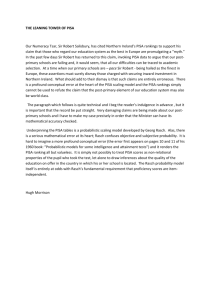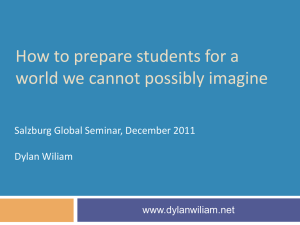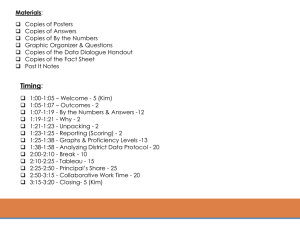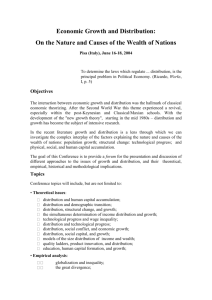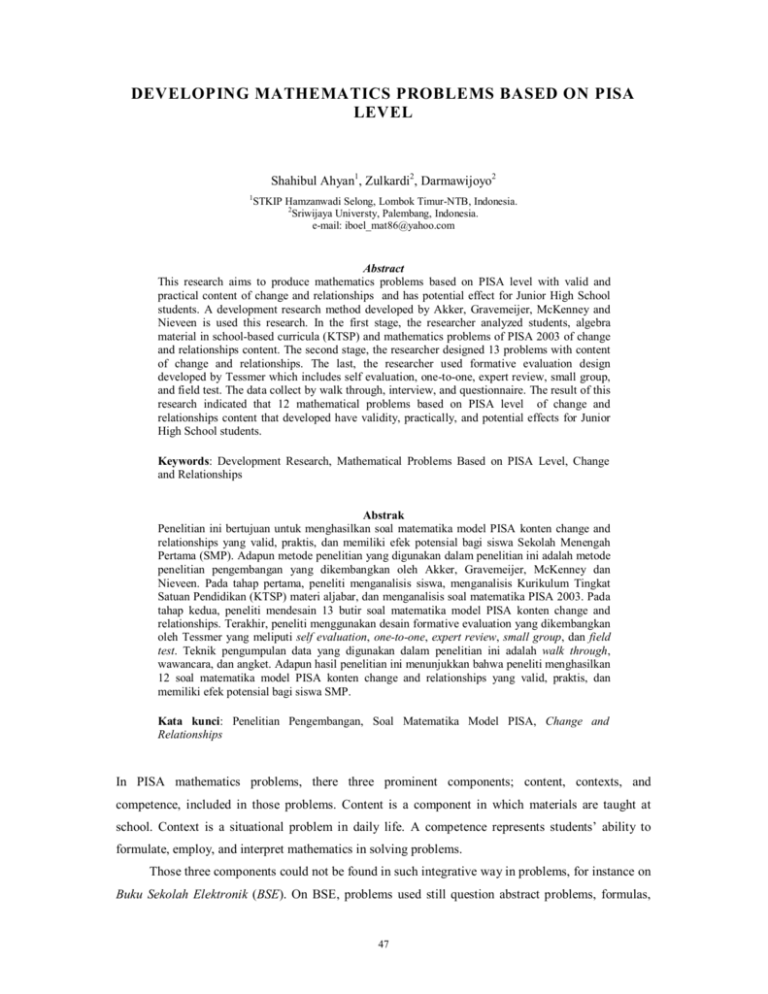
DEVELOPING MATHEMATICS PROBLEMS BASED ON PISA
LEVEL
Shahibul Ahyan1, Zulkardi2, Darmawijoyo2
1
STKIP Hamzanwadi Selong, Lombok Timur-NTB, Indonesia.
2
Sriwijaya Universty, Palembang, Indonesia.
e-mail: iboel_mat86@yahoo.com
Abstract
This research aims to produce mathematics problems based on PISA level with valid and
practical content of change and relationships and has potential effect for Junior High School
students. A development research method developed by Akker, Gravemeijer, McKenney and
Nieveen is used this research. In the first stage, the researcher analyzed students, algebra
material in school-based curricula (KTSP) and mathematics problems of PISA 2003 of change
and relationships content. The second stage, the researcher designed 13 problems with content
of change and relationships. The last, the researcher used formative evaluation design
developed by Tessmer which includes self evaluation, one-to-one, expert review, small group,
and field test. The data collect by walk through, interview, and questionnaire. The result of this
research indicated that 12 mathematical problems based on PISA level of change and
relationships content that developed have validity, practically, and potential effects for Junior
High School students.
Keywords: Development Research, Mathematical Problems Based on PISA Level, Change
and Relationships
Abstrak
Penelitian ini bertujuan untuk menghasilkan soal matematika model PISA konten change and
relationships yang valid, praktis, dan memiliki efek potensial bagi siswa Sekolah Menengah
Pertama (SMP). Adapun metode penelitian yang digunakan dalam penelitian ini adalah metode
penelitian pengembangan yang dikembangkan oleh Akker, Gravemeijer, McKenney dan
Nieveen. Pada tahap pertama, peneliti menganalisis siswa, menganalisis Kurikulum Tingkat
Satuan Pendidikan (KTSP) materi aljabar, dan menganalisis soal matematika PISA 2003. Pada
tahap kedua, peneliti mendesain 13 butir soal matematika model PISA konten change and
relationships. Terakhir, peneliti menggunakan desain formative evaluation yang dikembangkan
oleh Tessmer yang meliputi self evaluation, one-to-one, expert review, small group, dan field
test. Teknik pengumpulan data yang digunakan dalam penelitian ini adalah walk through,
wawancara, dan angket. Adapun hasil penelitian ini menunjukkan bahwa peneliti menghasilkan
12 soal matematika model PISA konten change and relationships yang valid, praktis, dan
memiliki efek potensial bagi siswa SMP.
Kata kunci: Penelitian Pengembangan, Soal Matematika Model PISA, Change and
Relationships
In PISA mathematics problems, there three prominent components; content, contexts, and
competence, included in those problems. Content is a component in which materials are taught at
school. Context is a situational problem in daily life. A competence represents students’ ability to
formulate, employ, and interpret mathematics in solving problems.
Those three components could not be found in such integrative way in problems, for instance on
Buku Sekolah Elektronik (BSE). On BSE, problems used still question abstract problems, formulas,
47
48
IndoMS-JME, Volume 5, No. 1, January 2014, pp. 47-56
and models which are far away from problems in PISA model. Problems given to students are
expressed in mathematics language and symbol organized in contexts that are not close to daily
problems. Furthermore, it can be said that recent problems used are not able to overlap students’
ability in solving problems in PISA. It results in students’ ability in solving problems of mathematics
models in PISA that is said to be low due to students are not accustomed to solve those problems in
their learning activity.
In PISA 2003, algebra and measurement were significantly questions more difficult for
Indonesia students than number, geometry, and data (Stacey, 2011: 118). It can be seen in the figure
below, Indonesian score got lowest score in change and relationships conten than the other contents.
Figure 1. Indonesian score in each content in PISA 2003 (Stacey, 2011: 217)
Based on the figure above shows that, in PISA 2003, change and relationships content was
getting the lowest score, 334. The other contents such as space and shape got 361, quantity 357, and
uncertainty 385. Therefore, based on that results, the Indonesian student must be taught to do
mathematical problems based on PISA level in learning, especially in the change and relationships
content.
PISA is study of literacy aimed to examine periodically the ability of 15-year-old students in
reading literacy, mathematical literacy, and scientific literacy. PISA assesses the extent to which 15year-old students can handle mathematics adeptly when confronted with situation and problems – the
majority of which are presented in real-world contexts (OECD, 2000). The study of PISA was first
conducted in 2000 and held every three years by Organisation for Economic Co-operation and
Development (OECD).
Students have mathematical literacy if students are able to formulate, implement, and interpret
mathematics in avariety of contexts that include mathematical reasoning and using mathematical
concepts, procedures, facts and tools to describe, explain, and predict the phenomena in everyday life.
This is explained in the framework of PISA 2012 as follows:
Mathematical literacy is an individual’s capacity to formulate, employ, and interpret
mathematics in a variety of contexts. It includes reasoning mathematically and using
Ahyan, et al., Developing Mathematics Problem …
49
mathematical concepts, procedures, facts, and tools to describe, explain, and predict
phenomena. It assissts individuals to recognise the role that mathematics plays in the world
and make the well-founded judgments and decisions needed by constructive, engaged and
reflective citizen (OECD, 2010).
All of the competencies of students referred mathematization. According to De Lange (1987),
mathematization is defined as the organization of activities in finding regularity, relations, and
structures using the knowledge and skills early. The problems in PISA are based on the real world that
students need to complete the process of mathematization to solve the real world problems
mathematically. Mathematising can be characterised as having five aspects: (1) starting with a
problem situated in reality; (2) organising it according to mathematical concepts; (3) gradually
trimming away the reality through processes such as making assumptions about which features of the
problem are important, generalising and formalising (which promote the mathematical features of the
situation and transform the real problem into a mathematical problem that faithfully represents the
situation); (4) solving the mathematical problem; and (5) making sense of the mathematical solution in
terms of real situation.
The characteristics of the mathematical PISA question consists of three components:
1. Mathematical content that is targeted for use in the assessment items, that is quantity; change and
relationships; space and shape; uncertainty and data.
2. The context in which the assessment items are located, that is personal, occupational, societal,
scientific.
3. The mathematical process that describe what individuals do to connect for the problem with the
mathematics and thus solve the problem, and the capabilities that underlie those processes, that is
reproduction, connection, reflection.
Change and relationships related to algebra in Kurikulum Tingkat Satuan Pendidikan (KTSP)..
Kaput (van de Walle, 2007) states that there are five forms of algebraic form: (1) generalization of
arimmetic and mathematical patterns; (2) the use of symbols that are quite useful; (3) learning about
the structure of the number system; (4) learning the pattern and functions; and (5) mathematical
modeling process, which brings together four ideas above. According to OECD (2009), the skills
needed to study the change and relationships is the ability to: (1) Presenting the change in the form of
an easily understood; (2) understand the types of fundamental changes; (3) recognizing the type of
change of an event; and (4) applying techniques of change in the real world.
METHOD
A development research method developed by Akker, Gravemeijer, McKenney and Nieveen is
used this research. This development research consists of three stages; analysis, design, and evaluation
50
IndoMS-JME, Volume 5, No. 1, January 2014, pp. 47-56
(Akker, et al., 2006). Analysis stage conducted an analysis of students, curriculum, and change and
relationships content. The second stage, design the product (mathematics problems based on PISA
level on change and relationships conten). The last stage, the researchers used formative evaluation
design (figure 2) which includes self evaluation, one-to-one, expert review, small group, and field test
(Tessmer, 1993; Zulkardi, 2006).
Figure 2. Formative evaluation design (Tessmer, 1993; Zulkardi, 2006)
The successful criteria of this research were obtained in the form of mathematics problems
based on PISA level on change and relationships content in valid, practice, and have potential effect
for the students. The validity can be determined by looking at the results of the expert validation
(expert review stage). The practicality of the problems can be known from the opinion of students and
observations in one-to-one and small group stage. Practicality means easy to use, can be administered
and interpreted properly, and also does not have a variery of meanings. The potential effects can be
determined in field tests based on the student answer, questionnaire and interview results. The results
of questionnaire and interview were analyzed whether students think about the effect it has potential to
explore students' mathematics skills. The results of the students' answers at the field test were also
used as material analysis to determine the potential effect.
Research subjects were junior high school students grade IX of Madrasah Tsanawiyah (MTs.)
Negeri 1 Palembang, SMP Negeri 17 Palembang, SMP Negeri 14 Palembang, and SMP Negeri 1
Palembang. The research was conducted on October 14, 2012 to December 5, 2012. However, the
data collection techniques in this research were: (1) walk through, it performed on expert review stage
to get valid in aspect of content, construct, and language of the mathematics problems from the expert
by e-tools (email, phone, and POS Indonesia); (2) interview, it performed on one-to-one, small group,
and field test stages to know mathematics problems practicality; and (3) questionnaire, it performed on
field test stage to know the potential effects of the mathematics problems.
The data collected was analyzed using descriptive analysis method: (1) analyzing the walk
through sheet based on the comments of experts in the expert review stage for getting the validity; (2)
analyzing interview results in the one-to-one, small group, and field test stage for getting the
Ahyan, et al., Developing Mathematics Problem …
51
practically and for knowing the potential effect; (3) analyzing the questionnaire sheet in the field test
stage for knowing the potential effect; and (4) analyzing the student answers for knowing the potential
effect.
RESULTS AND DISCUSSION
Analysis Stage
We conducted an analysis of students, curriculum and content of PISA about change and
relationships. Analysis of students aims to know the students who have the high, medium, and low
ability in mathematics. We analyzed 39 students: four students in one-to-one, six students in small
group, and 29 students in field test stage.
Then, the analysis of the curriculum aims to know what Standar Komepetensi (SK) and
Kompetensi Dasar (KD) of algebra in KTSP related to change and relationships in PISA. Based on the
analyzed, we got 3 SK (2, 3, and 4) and KD (2.3; 3.4; and 4.5) in VII grade, whereas in VIII grade, we
got 2 SK (1 and 2) and KD (1.1 and 2.3).
The last of the analysis stage was analysis of change and relationships content of PISA. In the
analysis, we got four characteristics of change and relationships in PISA: (1) Generalization of
numerical and geometrical patterns and of the laws governing numerical relationships; (2) problem
solving; (3) functional situations; and (4) modelling of physical and mathematical phenomena.
Design stage
We designed 13 mathematics problems based on PISA level on change and relationships. All of
the problems designed based on the content (according to the characteristics of PISA, in accordance
with the change and relationships, and in accordance with the level of ability of 15-year-old students);
construct (rich with mathematical concepts, inviting further concept development, using the command
prompt, or demanding answers unraveled, and there are clear instructions on how to do the problems);
and language (according to EYD, the matter does not contain a double interpretation, limits of
questions and answers clearly, and tables, pictures, and graphics on the matter functions and presented
in a clear and legible). According to us, all of the problems were change and relationships content.
Evaluation stage
a. Self Evaluation
We evaluated the questions that designed by ourselves. The purpose of this evaluation is to
know what the questions have three characteristics of PISA (content, context, and language). There is
no change on the problems that designed. The result of this stage namely prototype I.
b. Expert Review
Expert review serves to determine the validity of the problem based on the content, construct,
and language of prototype I. There are three expert who validating the prototype I: (1) Prof. Kaye
Stacey (The University of Melbourne, Australia); (2) Prof. Dr. Sutarto Hadi, M.Si., M.Sc. (Lambung
52
IndoMS-JME, Volume 5, No. 1, January 2014, pp. 47-56
Mangkurat University, Banjarmasin); and (3) Prof. Dr. M. Salman A.N. (Bandung Institute of
Technology, Bandung).
Prof. Kaye Stacey is one of Mathematics Expert Group (MEG) of PISA. I sent four problems to
her by email on Oktober 22th, 2012, and she gave comments about the prototype I on Oktober 25th,
2012. Her comments were: (1) these problems are all quite similar to released PISA items, so they
have the right ‘flavour’ for PISA; (2) all of your units have only one item. Some PISA units have more
than one item. But the items are designed to be statistically independent of each other as far as
possible; (3) I do not know what “problem level” is. However, if it is a measure of difficulty, I think
Batik problem will be easier than level 5; and (4) perhaps Unit 3 is “quantity” rather than change and
relationships. However, it is often quite difficult for people to agree on the classification.
Furthermore, I sent 13 problems to Prof. Dr. Sutarto Hadi, M.Si., M.Sc. and Prof. Dr. M.
Salman A.N. by email also, but both of them different tools to comment our problems. Prof. Dr.
Sutarto Hadi, M.Si., M.Sc. gave comments by writing down on the paper then sent to me, but Prof. Dr.
M. Salman A.N. gave cooments by phone. They said that all of the mathematics problems were good,
there were some sentences must be revised, and add the question item of the several units. They also
said that the problems included in change and relationships content of PISA, except the “election of
OSIS unit”. Based on three of experts comment, we revised the prototype I.
c. One-to-One
One-to-one and expert review conducted in parallel. One-to-one evaluation used four students
tested at different times and places. The students were Muhammad Akbar Barokah (MTs. Negeri 1
Palembang), Ainayah Fadilah (SMP Negeri 17 Palembang), Rizky Rosari (SMP Negeri 14
Palembang), and Ahmad Bagas E. (SMP Negeri 1 Palembang). They said that the problems were
difficult, so they didn’t answer some questions. Some of them such as Rizky and Ainayah were not
understood in some sentences of the problems. According to experts comment and students opinion,
we revised the prototype I became prototype II.
d. Small Group
Small group evaluation tested six students at different abilities. They were IX.2 grade students
of SMP Negeri 1 Palembang. They answered the 13 questions of prototype II, but two of them
couldn’t answered all of the questions. Almost all of them said that the problem clear enaough, they
also said the problems does not have a variery of meanings. Based on students' answers and
comments, the prototype II was revised became prototype III, 12 questions.
e. Field Test
Field test evaluation tested 29 students at different abilities. They were IX.1 grade students of
SMP Negeri 1 Palembang (figure 3). They answered the 12 questions of prototype III. After they
finished to answer the questions, they answered the questionnaire sheet, then we took seven of them to
take interview.
Ahyan, et al., Developing Mathematics Problem …
53
Figure 3. Students on field test
Based on the data of questionnaire, 24 students (83%) gave positive impression about the
mathematics problems such as figure 4. Then the interview result, six of seven students who
interviewed said that “we are interested to solve the problems because it can help sharpen our
thinking, so that the right-brain is functioning, not only the left-brain”. They also said that they were
more interested answer the questions like this, than the questions like in the handbooks generally.
Figure 4. Students statement about all of the problems
54
IndoMS-JME, Volume 5, No. 1, January 2014, pp. 47-56
Below is one of 12 questions that developed.
EGRANG GAME
The picture above is a picture of three children, namely Hendra, Sofyan, and Roni were
playing Egrang at the campsite. Distance (s) is the distance of child leg uses egrang in
order, which is given the formula
.
= 3, where:
n = number of steps per child per minute,
t = time in minutes,
s = distance in meters
Question:
If the above formula is used to calculate the distance of Hendra, where the number of
Hendra steps are 30 steps per minute. Calculate how many meters the distance of Hendra
for 1.5 minutes?
Content : change and relationships
Context
: personal
Competency
: reproduction
Prediction level : 2
Based on the field test result, 19 students (66%) answered correctly, 2 students (7%) correct part, and
9 students (31%) wrong answer. In the figure 5 below the example of the students answer, answer
correctly (figure 5.a), correct part (figure 5.b), and wrong answer (figure 5.c).
(a)
(b)
Figure 5. Students’ answer
(c)
Ahyan, et al., Developing Mathematics Problem …
55
CONCLUSION AND SUGGESTION
This research has been developing 12 questions of change and relationships content which was
valid, practical, and have potential effect. The validity of the problems known based on the comments
of three of expert on expert review stage: Prof. Kaye Stacey, Prof. Sutarto Hadi, M.Si., and Prof. Dr.
M. Salman A.N.. Then, the practicality of the problems known based on the opinion of students on
one-to-one and small group stage: the problems easy to use, the problems clear enough, and does not
have a variery of meanings. The last, the problems have potential effect because 24 students (83%)
gave positive impression about the mathematics problems. Then the interview result, six of seven
students who interviewed said that “we are interested to solve the problems because it can help
sharpen our thinking, so that the right-brain is functioning, not only the left-brain”. They also said that
they were more interested answer the questions like this, than the questions like in the book generally.
So, 12 questions of mathematics problem based PISA level on ahange and relationships content were
valid, practical, and have potential effects to the students.
REFERENCES
Akker J., Nieveen, N., & McKenney, S. (2006). Design research from a curriculum perspective. In
Akker J., Gravemeijer, K., McKenney, S. & Nieveen, N. (eds), Educational Design Research
(pp. 67-90). London: Routledge.
Akker J. (1999). Principles and methods of development research. In Akker J., R.Branch, K.
Gustafson, Nieven, & T. Plomp (eds), Design Approaches and Tools in Education and Training
(pp. 1-14). Dortrech: Kluwer Academic Publishers.
Depdiknas (2006). Kurikulum Tingkat Satuan Pendidikan. Jakarta: Depdiknas.
De Lange, J. (1987). Mathematics, Insight, and Meaning (Doctoral dissertation). Utrecht: OW & OC,
Utrecht University.
OECD. (2003). The PISA 2003 Assessment Framework - Mathematics, Reading, Science and Problem
Solving,
Knowledge
and
Skills.
Retrieved
March
2012,
from
http://www.oecd.org/edu/preschoolandschool/programmeforinternationalstudentassessmentpisa/
33694881.pdf.
OECD. (2009). Learning Mathematics for Life: a view perspective from PISA. Retrieved March 2012,
from http://www.oecd.org/pisa/pisaproducts/pisa2003/44203966.pdf.
OECD. (2009). PISA 2009 Assessment Framework-Key Competencies in Reading, Mathematics, and
Science. Retrieved March 2012, from http://www.oecd.org/pisa/pisaproducts/44455820.pdf.
OECD. (2009). PISA Take the Test: sample questions from the OECD's PISA assessments. Retrieved
March 2012, from http://www.oecd.org/pisa/pisaproducts/pisa2006/41943106.pdf.
OECD. (2010). PISA 2012 Mathematics Framework.
http://www.oecd.org/dataoecd/8/38/46961598.pdf.
Retrieved
March
2012,
from
Stacey, K. (2010). The PISA View of Mathematical Literacy in Indonesia. Journal on Mathematics
Education (IndoMS-JME), 2(2), 95-126. Palembang: IndoMS.
Tessmer, M. (1993). Planning and Conducting Formative Evaluation. Philadelphia: Kogan Page.
56
IndoMS-JME, Volume 5, No. 1, January 2014, pp. 47-56
Van de Walle, J. A. (2007). Elementary and Midle School Mathematics, Sixth Edition. USA: Pearson
Prentice Hall.
Zulkardi (2006). Formative Evaluation:What, Why, When, and How. Retrieved September 2012, from
http://www.reocities.com/zulkardi/books.html.


